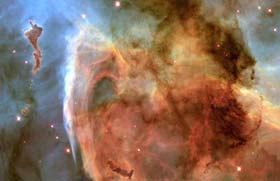Carina Nebula (NGC 3372)

The Carina Nebula (NGC 3372) <br>Credits: NASA, The Hubble Heritage Team (AURA/STScI)
Previously unseen details of a mysterious, complex structure within the Carina Nebula (NGC 3372), also called the ’Keyhole Nebula’, are revealed by this image obtained with the NASA/ESA Hubble Space Telescope.
The picture is a montage assembled from four different April 1999 telescope pointings with Hubble’s Wide Field Planetary Camera 2, which used six different colour filters.
The picture is dominated by a large, approximately circular feature, about 7 light-years across, which is part of the Keyhole Nebula, named in the 19th century by British astronomer Sir John Herschel. This region, about 8000 light-years from Earth, is located near to the famous explosive variable star Eta Carinae, which lies just outside the field of view toward the upper right.
The Carina Nebula also contains several other stars that are among the hottest and most massive known, each about 10 times as hot, and 100 times as massive, as our Sun.
The circular ’keyhole’ structure contains both bright filaments of hot gas and dark silhouetted clouds of cold molecules and dust, all of which are in rapid, chaotic motion. Two striking large, sharp-edged dust clouds are located near the bottom centre and upper-left edges of the image. These large dark clouds may eventually evaporate or, if there are sufficiently dense condensations within them, give birth to small star clusters.
The Carina Nebula, with an overall diameter of more than 200 light-years, is one of the outstanding features of the southern-hemisphere part of the Milky Way.
Media Contact
More Information:
http://www.esa.int/export/esaSC/SEMAJS374OD_sensations_0.htmlAll latest news from the category: Physics and Astronomy
This area deals with the fundamental laws and building blocks of nature and how they interact, the properties and the behavior of matter, and research into space and time and their structures.
innovations-report provides in-depth reports and articles on subjects such as astrophysics, laser technologies, nuclear, quantum, particle and solid-state physics, nanotechnologies, planetary research and findings (Mars, Venus) and developments related to the Hubble Telescope.
Newest articles

Future AR/VR controllers could be the palm of your hand
Carnegie Mellon University’s EgoTouch creates simple interfaces for virtual and augmented reality. The new generation of augmented and virtual reality controllers may not just fit in the palm of your…

‘Game changer’ in lithium extraction
Rice researchers develop novel electrochemical reactor. A team of Rice University researchers led by Lisa Biswal and Haotian Wang has developed an innovative electrochemical reactor to extract lithium from natural…

The blue-green sustainable proteins of seaweed
… may soon be on your plate. The protein in sea lettuce, a type of seaweed, is a promising complement to both meat and other current alternative protein sources. Seaweed…



